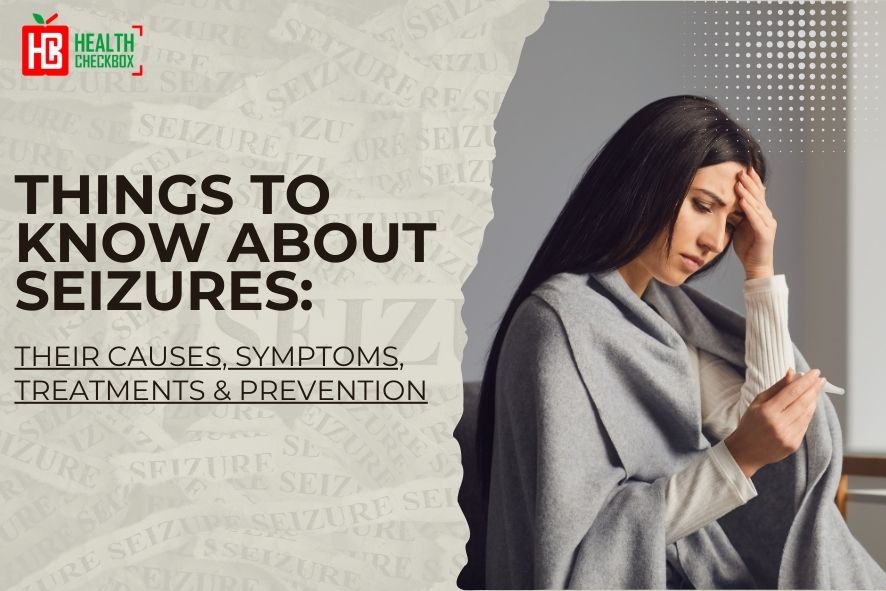Doctors term the occurrence of an abnormal electrical activity in the brain a seizure. The most visible signs of this ill-health include a short-lived loss of consciousness and convulsions (uncontrolled movements). Seizure types also differ from their point of start in the brain to how far they can spread. This sudden burst lasts from 30 seconds to 2 minutes. An attack lasting for more than 5 minutes is a case of medical emergency.
You are likely to acquire a seizure after a stroke or an injury to the head. Researchers have yet to find seizures, as a lot of activities keep happening inside the brain. Some examples include changes in the blood sugar level, falling sick, and getting an injury. A healthcare expert is the right person to find an appropriate treatment for one’s condition.
Types of Seizures
Mainly two types of seizures are common:
- Generalized seizures: The sudden burst of activity begins on both sides of the brain simultaneously. Both sides of your body may shake or only one side may shake. Muscles getting stiff usually in the arms, legs, and back are noticed in such a case.
- Focal seizures: Electrical activity occurs on only one side of the brain. One side of the body shows symptoms. You may or may not be aware of this. focal seizure treatment can help to recover the patient’s condition before any major concerns.
How Common is a Seizure?
Almost 10% of people worldwide are likely to have one seizure throughout their life.
Causes
An abnormal burst of electrical activity in the brain causes all known seizures. Nerve cells or neurons send electrical signals to various parts of the brain. During a seizure, the part
of the brain affected, fires signals uncontrollably to others surrounding them. This type of electrical activity overloads the part of the brain and results in symptoms of
seizure.
1) There are Mainly 2 Categories that Seizure Fall Into:
- Non epileptic or provoked seizure: It occurs when a trigger, such as a transitory condition or certain conditions, generates seizure symptoms.
- Epileptic or unprovoked seizures: They may occur frequently. These episodes are the basic signs of epilepsy.
2) Causes of Seizures can Include:
Some of the predominant causes of seizures include:
a) Brain damage:
- Severe head injury.
- Brain infection, including meningitis and encephalitis.
- Brain tumor (a rare cause).
- Lack of oxygen when born.
- Congenital brain defects
b) Medications:
- Abnormal levels of sodium or glucose in the blood.
- Withdrawal from certain medicines after using it for a long time.
c) Other health conditions:
- Heart disease.
- Aneurysms.
- Cerebral hypoxia.
- Diabetes.
- Toxemia of pregnancy.
- Toxin buildup in the body due to liver or kidney failure.
- Blood pressure that is very high.
- Genetic condition.
- Prolonged ill-health of the brain like Alzheimer’s disease or frontotemporal dementia.
Triggers for seizures include:
- Drug or alcohol use or withdrawal.
- Malnutrition or dehydration.
- Flickering or flashing lights.
- A disturbed sleeping pattern.
- High fever.
- Abnormal blood sugar levels (low or very high).
At times, it is difficult to get to any definite cause for the condition. It is then known as an idiopathic seizure. This is more noticeable in children and youngsters. A family history of epilepsy or seizures can also persist.
Symptoms
Specific symptoms depend on which part of the brain involves the electrical activity. These can occur all of a sudden and vary from a mild one to serious one. The indications can be mild and include:
- Jerky movements: An uncontrollable shaking of the arms and legs. Convulsions and muscle spasm may alsopersist. This may be unstoppable.
- Loss of consciousness: A person loses consciousness all of a sudden.
- Staring: The person becomes blank and is unresponsive.
- Abnormal sensation or behavior: Mood swings that include, sudden anger, panic, joy, or fear that is unaccountable. People may experience a strange smell, taste, or sensation in their hands or feet.
Certain Warning Signs Before the Attack Include:
- Sensory symptoms: These include seeing bright lights or distortions in how objects appear, hearing odd sounds, unexpected tastes or scents (metallic or bitter), and strange skin sensations (numbness or tingling).
- Emotional shifts: It include strong feelings such as fear or delight and déjà vu (when a new event feels familiar).
- Autonomic symptoms: These impact bodily systems that your brain controls automatically, such as perspiration, excessive salivation (drooling), upset stomach, and pale complexion.
Not everyone has warning symptoms before a seizure.
Diagnosis
Various tests to indicate this condition include:
- Blood tests
- Computed tomography test
- Electroencephalogram
- Magnetic resonance imaging
- Positron emission tomography (PET) scan
Risk Associated with Seizures
You are likely to have seizures at any age. You are more at risk if you:
- Are a victim of an underlying condition.
- Have a family history of seizures.
- Are young below the age of 18.
- Are over the age of 50.
Seizures and their Management
Seizure treatments vary according to the type, intensity, and cause.
Your healthcare provider might recommend the following:
- Managing any underlying causes or conditions: Your doctor will first address any underlying issues, such as a stroke or low blood sugar. This could prevent future seizures.
- Taking anti-seizure medicines: Medications can help prevent seizures or reduce their frequency.
- Brain stimulation: A surgeon will insert a device into your brain. It will produce a small electrical current. The current interferes with and attempts to prevent aberrant electrical activity. There are several types of brain stimulation available, including vagus nerve stimulation.
- Surgery: It can lessen seizure frequency and severity by targeting the part of the brain where seizures begin (focal point).
Can a Seizure be Avoided?
Seizures are unpredictable. Thus, they cannot be prevented. The greatest thing you can do is avoid potential causes or triggers. It can include:
- Controlling blood glucose levels
- Safeguarding yourself from illness and injury.
Home Care for Seizure Patients
When a seizure occurs, the primary priority is to safeguard the person from injury. The below tips come in handy in this case:
- Try to avoid a fall. Lay the person on the ground, at a safe location. Clear the area of any furniture or sharp objects.
- Cushion the person’s head.
- Loosen tight clothing, particularly around the neck.
- Turn the person to their side. If vomiting occurs, it makes sure that the vomit does not enter the lungs.
- Look for a medical ID bracelet that has seizure instructions.
- Stay with the patient until they recover or expert medical care arrives.
Conclusion
Seizures are temporary signs and symptoms of a burst of electrical neuron activity in the brain. Nearly 10% of grownups have had a seizure in their life. This is more in case of people
who are over 55 years. Around 30% of people are victims of recurrent seizures and they have experienced an initial unprovoked seizure within a year. Provoked seizures have less chance of recurring, especially when provoking factors have been sorted out.

